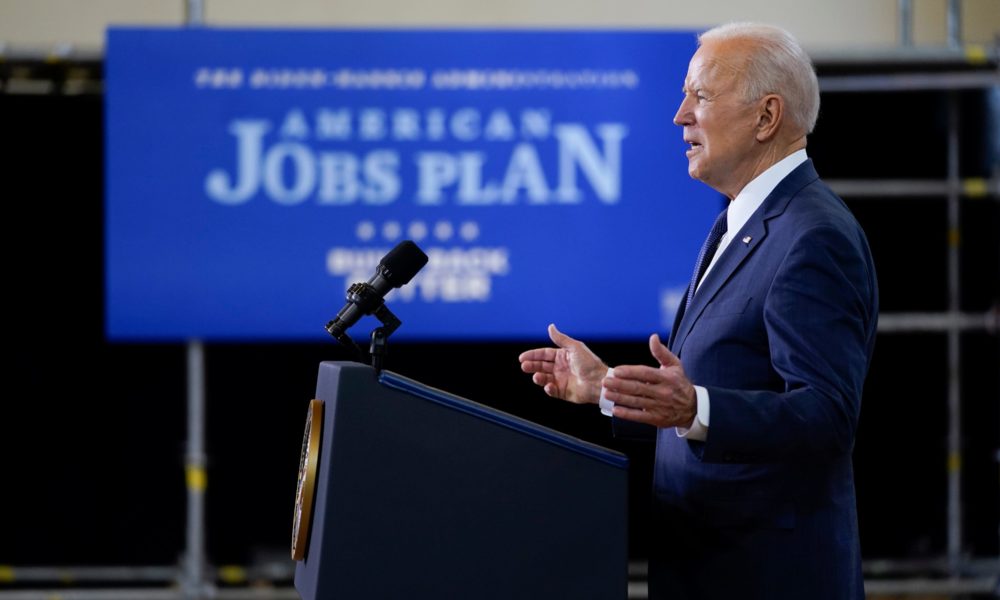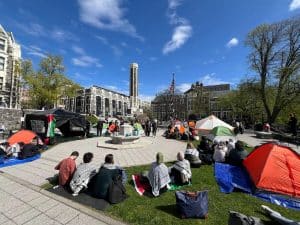Speaking at a carpenters’ union training center in Pittsburgh, Pennsylvania late last month, President Biden unveiled the details of a $2 trillion jobs program that would invest billions in improving transportation, housing, and communication infrastructure. The proposal follows a $1.9 trillion stimulus package passed earlier last month and is the second of a three-part plan intended to address the economic fallout of the pandemic, looming climate disaster, and decades of underfunding and disinvestment in infrastructure and human services. All told, these plans could total between $4 and $6 trillion if passed as proposed.
This level of spending, not seen since at least the Johnson administration, is an unprecedented departure from the fiscal policies of the neoliberal era and reveals not only the depth of the interlocking crises faced by the United States, but also the degree to which the ruling class fears the continued possibility of economic instability and wide-ranging social and political unrest. Decades of low wages, disinvestment, widening inequality, and lack of access to basic services like healthcare and education, have polarized U.S. politics, giving rise to new forms of populist outrage on both the Right and the Left. More recently, the Trump administration, the coronavirus pandemic, and the bungled response that followed devastated an already weak economy and, along with the police murder of George Floyd, helped precipitate a series of massive and volatile uprisings against the police state in hundreds of cities across the country. These uprisings were then followed by a violent right wing backlash that culminated in the storming of the U.S. Capitol in January.
The collapse of the economy has also left tens of millions in poverty or on the verge of homelessness, and many millions more remain unemployed or underemployed, even as millions of young workers continue to enter the job market. While economic growth in the first quarter of 2021 has picked up considerably compared to 2020 and is expected to top 6 percent for the year, the prospects for a long term economic recovery are far less sanguine, and the potential for more unrest remains, particularly if nothing is done to reduce unemployment. As a consequence, the Biden administration, in its role as the caretaker of American capitalism, is betting that a massive injection of cash and jobs directly into the economy will save capitalism from itself, at least temporarily. Whether or not such unprecedented investments stand a chance of passing congress and whether or not they will have any lasting impact on the economy remains to be seen.
Left Voice is hosting a panel with a Bessemer Amazon worker and Robin D.G. Kelly, author of Hammer and Hoe, to discuss the results of the unionization vote. Sign up and RSVP to the Facebook event.
But this proposal is about more than just the health of the U.S. economy. As President Biden made clear in his speech, and as the White House fact sheet on the proposal repeats with gusto, the American Jobs Plan is primarily an attempt to “position the United States to out-compete China.” And indeed, Biden’s Jobs Plan is in many ways a carbon copy of China’s “Made in China 2025” initiative, which is investing heavily in domestic industries, particularly electric vehicles and semiconductor research and manufacturing. In this respect the proposal is an explicit attempt to both restore U.S. legitimacy among the international community and to reassert itself in its continued economic and diplomatic competition with China.
U.S. imperialism, costly military interventions in Afghanistan and Iraq, neoliberal austerity, absurdly low corporate taxes, and privatization have not only devastated the living standards of working people in the United States — not to mention the livelihoods of countless millions across the world — but have weakened the influence of the United States as a global imperialist power. As China continues to grow its economy and consolidate its regional influence through the Belt and Road Initiative, creating infrastructure projects across Southern and Central Asia, the United States can hardly maintain its own dilapidated bridges, roads, ports, and rail lines. Biden’s proposal is a calculated attempt to counter the narrative (true in many respects) of the ongoing decline of U.S economic and military influence and power.
Towards this end, the plan includes a wide-ranging set of investments designed to spur short-term economic recovery and technological and industrial competitiveness. Although spending is spread out over eight years, the plan is still a one-time investment that, unlike the New Deal or the “Great Society” programs of the Johnson administration, does not actually create any long-term programs or structural changes to the economy. Worse, much of the spending will not actually go to infrastructure, but directly into the pockets of corporations and businesses. Among the largest investments are $400 billion in Medicaid funding to support home health care for the elderly and disabled, $300 billion to bolster manufacturing, $200 billion for affordable housing, and almost $400 billion more for research and development of semiconductors, green energy, and health technologies. The plan also includes smaller investments in water, electrical, and communication infrastructure, with $40 billion to replace lead water pipes, $100 billion for high speed broadband construction, $100 billion for the electrical grid, and $100 billion for school construction. Of the remaining investments directly related to transportation, $115 billion is planned for the repair and construction of highways, roads, and bridges, and $175 billion is slated to promote the sale and use of electric vehicles, including 50,000 charging stations and direct subsidies to manufacturers and consumers to incentivize electric vehicle purchases. By contrast, the plan invests merely $85 billion in already existing public transportation, a decision that will unfortunately only further encourage reliance on private vehicles and all of the subsequent social and environmental ills that follow from that.
Although the Biden administration has proposed to fund the majority of this spending with a partial rollback of President Trump’s massive 2017 corporate tax cut (increasing the maximum tax rate from 21 to 28 percent), this would still leave the maximum tax rate for corporations seven points lower than it was during the Reagan presidency and only a little more than half of its historic high of 52 percent in 1968. While this aspect of the proposal has rattled some investors and corporate leaders, many of the biggest corporations in the United States pay zero in corporate taxes, and 400 of the top Fortune 500 corporations have an average tax liability of just 11 percent, far below even the current rate. While taxes may go up for some corporations, including Amazon (which has announced that it supports Biden’s proposal), the plan would be a windfall for many others. As even the Wall Street Journal admits, Biden’s plan would give away hundreds of billions of dollars directly and indirectly to companies and corporations. In particular, the electric vehicle sector, the semiconductor manufacturing industry, fibre optic cable producers, green energy manufacturers, landlords, and construction companies will all receive billions in contracts or direct subsidies. It is no surprise that Tesla stock has jumped almost 6 percent since the period immediately before the announcement, or that tech stocks have seen a similar boost.
So far, the plan has received wide support from bourgeois economists, but it still faces significant opposition from congressional Republicans, who have balked at the idea of paying for any infrastructure programs through increased taxes. But they are not alone in criticizing the plan. Progressives within the President’s own party are also unhappy and have loudly complained that the proposal does not go far enough to solve the economic and ecological problems facing the country. As DSA and Progressive Caucus member Alexandria Ocasio Cortez argued, the $40 billion proposed for public housing, for instance, would not be sufficient to even bring New York City’s public housing up to code, much less create or improve new or existing public housing. Meanwhile, the limited investments in green energy come nowhere near the amount of money needed to set the United States on a path to meet the already compromised Paris Agreement targets for reduction of greenhouse gases.
While the plan has a good chance of passing the House, it would likely require another budget reconciliation process (like the one used to pass Biden’s last stimulus package) in order to pass the Senate. Conservative Democratic Senator Joe Manchin, who is an opponent of eliminating the filibuster, however, has suggested that he will not vote for an infrastructure bill that does not have Republican support. If this happens, Biden’s plan could be carved up into several different bills. Either way, it is almost certain that, like the stimulus package passed last month, many of the most progressive parts of the proposal will be left out or watered down considerably. In fact, Biden has already indicated that he is willing to negotiate with Congressional Republicans on how to fund the bill, stating that he is “wide open” to the possibility of a corporate tax rate lower than 28 percent.
Regardless of whether or not Biden’s Jobs Plan passes in its current form, or whether or not it includes significant increases in corporate taxes, this proposal represents a dramatic shift in the economic policy of the U.S. state, one that socialists and revolutionaries everywhere should study carefully. Even the ruling class now recognizes that the neoliberal project has failed miserably, and it is scrambling to find an answer to the crises it has created. The Biden administration’s response to these unfolding elements of organic crisis facing the United States marks a possible return to a kind of direct and broad-based state intervention and investment in the economy that has not been seen since the period following the Second World War.
But this is not the 1950s, and there is simply no way, despite what many bourgeois economists are arguing, for capital to recreate the conditions of the welfare state boom of the post war period. Though a welcome development in some ways, this jobs plan will do little to address the long term crises faced by the U.S. economy and the state. The fact that such spending is happening in the name of restoring U.S. hegemony, however, should give working people pause. While competition with China may translate into more spending and more direct government intervention into the economy in the short term, such imperialist conflicts — as the Pentagon’s latest budget makes plain — are not in the long term interests of working people. Not for those in the United States, and certainly not those who are oppressed by the military and economic policies of the United States abroad.
Biden’s ongoing attempts to co-opt and appease the outrage and frustration of organized labor and social movements such as Black Lives Matter, shows that working class anger and self-organization have the power to force change. However, we have to remember where our real power lies. Whether or not such investments as the Jobs Program will continue and whether or not they will actually benefit the working class will depend much more upon how working people respond to this moment than the political composition of congress. This means that working people cannot allow our organizations and our energies to be co-opted by the Democratic Party, nor can we allow ourselves to be fooled into thinking that elected officials will solve our problems for us.
The massive uprisings last summer sent a clear message to the ruling class that was more powerful than any election result. If we wish to win anything more than crumbs from the bosses’ tables, if we wish to create a real infrastructure plan that actually addresses climate change and environmental degradation and provides for the real needs of the working class beyond the artificial health of an economy built on exploitation, we need to continue to demonstrate, disrupt, and most importantly organize to defeat the capitalist class once and for all.











